South African Consumers’ Knowledge, Opinions and Awareness of Whole Grains and Their Health Benefits: A Cross-Sectional Online Survey
Abstract
1. Introduction
2. Materials and Methods
2.1. Study Design and Implementation
- How well respondents thought they understood the term whole grains (subjective knowledge) and how well they understood the term (objective knowledge).
- Their objective knowledge as to which food ingredients are whole grains and which food products generally contain whole grains.
- What attributes, including sensory characteristics, cost and affordability, product labeling, product availability, and consumer marketing, they most associated with whole-grain foods.
- What they understood to be the major health benefits of consuming whole grains.
- Whether they knew the quantity of whole grains it is recommended that people consume and whether they thought that they were consuming enough whole grains.
2.2. Statistical Analysis
3. Results
3.1. Participant Characteristics
3.2. Univariate Results and Socio-Demographic Factors Associated with Whole Grains Knowledge, Attitudes and Behaviors
3.2.1. Whole-Grain Knowledge
3.2.2. Objective versus Subjective Whole-Grain Knowledge
3.2.3. Whole-Grain Attitudes and Behavior
3.2.4. Attributes of Whole-Grain Food Products
4. Discussion
4.1. Whole-Grain Knowledge
4.2. Attributes of Whole-Grain Food Products
4.3. Approaches to Increasing Whole-Grain Consumption-Specific Considerations for Developing Countries
4.4. Strengths and Limitations of the Study
5. Conclusions
- Consistent labeling: It is crucial to ensure that the labeling of whole-grain products aligns with the global approach, such as that followed by the Whole Grains Council. Standardizing the labeling requirements will provide clarity to consumers and enable them to make informed choices.
- Specification in dietary guidelines: To further support whole-grain consumption, it is recommended that the Food-Based Dietary Guidelines specify the recommended amounts of whole grains to be consumed per day. Clear guidelines will assist consumers to understanding the appropriate intake levels and incorporate whole grains into their diets.
- Increased consumer awareness: A government-led communication campaign should be implemented to enhance consumer awareness of the health benefits associated with whole grains. This campaign can educate the public about the nutritional value of whole grains and promote their inclusion in daily meals.
- Affordability through taxation exemption: To make whole-grain products more affordable for consumers, taxation exemptions should be extended to products containing significant amounts of whole grains. This would ensure that the prices of these products are comparable to those of regular items, encouraging consumers to choose whole-grain options.
- Research and development of appealing whole-grain products: Collaboration between the industry and academia is crucial for the development of good tasting and nutritionally dense whole-grain products. To meet consumer expectations, these products should be shelf-stable and less prone to rancid off-flavor development. Research efforts should focus on improving the taste and texture of whole-grain products to make them more appealing to a wider consumer base.
Supplementary Materials
Author Contributions
Funding
Institutional Review Board Statement
Informed Consent Statement
Data Availability Statement
Acknowledgments
Conflicts of Interest
References
- Ferruzzi, M.G.; Jonnalagadda, S.G.; Liu, S.; Marquart, L.; McKeown, N.; Reicks, M.; Riccardi, G.; Seal, C.; Slavin, J.; Thielecke, F. Developing a Standard Definition of Whole-Grain Foods for Dietary Recommendations: Summary Report of a Multidisciplinary Expert Roundtable Discussion. Adv. Nutr. 2014, 5, 164–176. [Google Scholar] [CrossRef] [PubMed]
- Ross, A.B.; van der Kamp, J.W.; King, K.; Lê, A.; Mejborn, H.; Seal, C.J.; Thielecke, F. Perspective: A Definition for Whole-Grain Food Products-Recommendations from the Healthgrain Forum. Adv. Nutr. 2017, 8, 525–531. [Google Scholar] [CrossRef] [PubMed]
- Slavin, J.L. Whole Grains, Refined Grains and Fortified Refined Grains: What’s the Difference? Asia Pac. J. Clin. Nutr. 2000, 9, S23–S27. [Google Scholar] [CrossRef]
- Mellen, P.B.; Walsh, T.F.; Herrington, D.M. Whole Grain Intake and Cardiovascular Disease: A Meta-Analysis. Nutr. Metab. Cardiovasc. Dis. 2008, 18, 283–290. [Google Scholar] [CrossRef] [PubMed]
- Aune, D.; Norat, T.; Romundstad, P.; Vatten, L.J. Whole Grain and Refined Grain Consumption and the Risk of Type 2 Diabetes: A Systematic Review and Dose–Response Meta-Analysis of Cohort Studies. Eur. J. Epidemiol. 2013, 28, 845–858. [Google Scholar] [CrossRef]
- Hu, Y.; Ding, M.; Sampson, L.; Willett, W.C.; Manson, J.E.; Wang, M.; Rosner, B.; Hu, F.B.; Sun, Q. Intake of Whole Grain Foods and Risk of Type 2 Diabetes: Results from Three Prospective Cohort Studies. BMJ 2020, 370, m2206. [Google Scholar] [CrossRef]
- Swaminathan, S.; Dehghan, M.; Rajm, J.M.; Thomas, T.; Rangarajan, S.; Jenkins, D.; Mony, P.; Mohan, V.; Lear, S.A.; Avezum, A. Associations of Cereal Grains Intake with Cardiovascular Disease and Mortality across 21 Countries in Prospective Urban and Rural Epidemiology Study: Prospective Cohort Study. BMJ 2021, 372, m4948. [Google Scholar] [CrossRef]
- Global Burden of Disease Collaborators. Global Burden of 87 Risk Factors in 204 Countries and Territories, 1990–2019: A Systematic Analysis for the Global Burden of Disease Study 2019. Lancet 2020, 396, 1223–1249. [Google Scholar] [CrossRef]
- Mann, K.D.; Pearce, M.S.; McKevith, B.; Thielecke, F.; Seal, C.J. Low Whole Grain Intake in the UK: Results from the National Diet and Nutrition Survey Rolling Programme 2008–11. Br. J. Nutr. 2015, 113, 1643–1651. [Google Scholar] [CrossRef]
- Kissock, K.R.; Neale, E.P.; Beck, E.J. Knowledge, Messaging, and Selection of Whole-Grain Foods: Consumer and Food Industry Perspectives. J. Nutr. Educ. Behav. 2022, 54, 1086–1098. [Google Scholar] [CrossRef]
- Barrett, E.M.; Foster, S.I.; Beck, E.J. Whole Grain and High-Fibre Grain Foods: How Do Knowledge, Perceptions and Attitudes Affect Food Choice? Appetite 2020, 149, 104630. [Google Scholar] [CrossRef]
- Foster, S.; Beck, E.; Hughes, J.; Grafenauer, S. Whole Grains and Consumer Understanding: Investigating Consumers’ Identification, Knowledge and Attitudes to Whole Grains. Nutrients 2020, 12, 2170. [Google Scholar] [CrossRef]
- Koo, H.C.; Poh, B.K.; Ruzita, A.T. Development, Validity and Reliability of a Questionnaire on Knowledge, Attitude and Practice (Kap) Towards Whole Grain among Primary School Children in Kuala Lumpur, Malaysia. Int. Food Res. J. 2016, 23, 797. [Google Scholar]
- Ugunesh, D.; Siau, C.S.; Sanip, M.N.A.B.; Koo, H.C. Perceived Barriers Towards Whole Grain Consumption among the Malaysian Adult Population: Findings from a Theory-Based Qualitative Study. Br. Food J. 2023, 125, 1130–1147. [Google Scholar] [CrossRef]
- Neo, J.E.; Brownlee, I.A. Wholegrain Food Acceptance in Young Singaporean Adults. Nutrients 2017, 9, 371. [Google Scholar] [CrossRef]
- McMackin, E.; Dean, M.; Woodside, J.V.; McKinley, M.C. Whole Grains and Health: Attitudes to Whole Grains against a Prevailing Background of Increased Marketing and Promotion. Public Health Nutr. 2013, 16, 743–751. [Google Scholar] [CrossRef]
- Wongprawmas, R.; Sogari, G.; Menozzi, D.; Pellegrini, N.; Lefebvre, M.; Gómez, M.I.; Mora, C. Determinants of Us University Students’ Willingness to Include Whole Grain Pasta in Their Diet. Int. J. Environ. Res. Public Health 2021, 18, 3173. [Google Scholar] [CrossRef]
- Flynn, L.R.; Goldsmith, R.E. A Short, Reliable Measure of Subjective Knowledge. J. Bus. Res. 1999, 46, 57–66. [Google Scholar] [CrossRef]
- South African Government, Department of Health. Regulations Relating to the Labelling and Advertising of Foodstuffs, R. 146. 2010. Available online: https://www.gov.za/sites/default/files/gcis_document/201409/32975146.pdf (accessed on 1 June 2023).
- South African Government, Department of Health. Regulations Relating to the Labelling and Advertising of Foodstuffs, R. 3337. 2023. Available online: https://www.gov.za/sites/default/files/gcis_document/202304/48460rg11575gon3337.pdf (accessed on 1 June 2023).
- United States Department of Agriculture, Foreign Agricultural Service. Understanding the Living Standards Measure Segmentation in South Africa. Available online: https://www.fas.usda.gov/data/south-africa-understanding-living-standards-measure-segmentation-south-africa (accessed on 1 June 2023).
- van der Kamp, J.W.; Jones, J.M.; Miller, K.B.; Ross, A.B.; Seal, C.J.; Tan, B.; Beck, E.J. Consensus, Global Definitions of Whole Grain as a Food Ingredient and of Whole-Grain Foods Presented on Behalf of the Whole Grain Initiative. Nutrients 2022, 14, 138. [Google Scholar] [CrossRef]
- Donoghue, S.; Wilken-Jonker, I.; Steffens, F.E.; Kirsten, J.F. South African Consumers’ Willingness to Pay a Premium for Karoo Lamb: The Influence of Subjective and Objective Knowledge, Label Information and Demographics. J. Retail. Consum. Serv. 2021, 63, 102664. [Google Scholar] [CrossRef]
- Gámbaro, A.; Ellis, A.C.; Prieto, V. Influence of Subjective Knowledge, Objective Knowledge and Health Consciousness on Olive Oil Consumption—A Case Study. Food Nutr. Sci. 2013, 4, 445. [Google Scholar] [CrossRef]
- Ljubicic, M.; Saric, M.M.; Rumbak, I.; Baric, I.C.; Komes, D.; Satalic, Z.; Guiné, R.P.F. Knowledge About Dietary Fibre and Its Health Benefits: A Cross-Sectional Survey of 2536 Residents from across Croatia. Med. Hypotheses 2017, 105, 25–31. [Google Scholar] [CrossRef] [PubMed]
- National Agricultural Marketing Council, Farm-to-Retail-Price-Spread. May 2020. Available online: https://www.namc.co.za/wp-content/uploads/2020/06/namc-farm-to-fetail-price-spread-May-2020.pdf (accessed on 1 June 2023).
- Delcour, J.A.; Hoseney, R.C. Principles of Cereal Science and Technology, 3rd ed.; Cereal and Grains Association: St. Paul, MN, USA, 2010. [Google Scholar]
- Wikipedia, Corn Flakes. Available online: https://en.Wikipedia.Org/Wiki/Corn_Flakes (accessed on 1 June 2023).
- Mugie, S.M.; Benninga, M.A.; Di Lorenzo, C. Epidemiology of Constipation in Children and Adults: A Systematic Review. Best Pract. Res. Clin. Gastroenterol. 2011, 25, 3–18. [Google Scholar] [CrossRef] [PubMed]
- Buford, T.W. (Dis)Trust Your Gut: The Gut Microbiome in Age-Related Inflammation, Health, and Disease. Microbiome 2017, 5, 80. [Google Scholar] [CrossRef] [PubMed]
- Rehm, C.D.; Peñalvo, J.L.; Afshin, A.; Mozaffarian, D. Dietary Intake among US Adults, 1999–2012. JAMA 2016, 315, 2542–2553. [Google Scholar] [CrossRef]
- Tester, J.M.; Stiers, K.B.; Garber, A.; Leung, C.W. Whole Grain Intake and Impaired Fasting Glucose in Adolescents, National Health and Nutrition Examination Survey, 2005–2014. Prev. Chronic Dis. 2020, 17, E130. [Google Scholar] [CrossRef]
- Grunert, K.G.; Wills, J.M.; Fernández-Celemín, L. Nutrition Knowledge, and Use and Understanding of Nutrition Information on Food Labels among Consumers in the UK. Appetite 2010, 55, 177–189. [Google Scholar] [CrossRef]
- van der Merwe, D.; du Preez, M.; Dreyer, H.; de Beer, H.; Mielmann, A.; Wyma, L. Informed Decision-Making: A Narrative Review of Working Female Middle-Class Consumers. J. Consum. Sci. 2020, 48, 1–8. [Google Scholar]
- Bolha, A.; Blaznik, U.; Korošec, M. Influence of Intrinsic and Extrinsic Food Attributes on Consumers’ Acceptance of Reformulated Food Products: A Systematic Review. Slov. J. Public Health 2020, 60, 72–78. [Google Scholar] [CrossRef]
- Symmank, C. Extrinsic and Intrinsic Food Product Attributes in Consumer and Sensory Research: Literature Review and Quantification of the Findings. Manag. Rev. Q. 2019, 69, 39–74. [Google Scholar] [CrossRef]
- Espejel, J.; Fandos, C.; Flavian, C. The Role of Intrinsic and Extrinsic Quality Attributes on Consumer Behaviour for Traditional Food Products. Manag. Serv. Qual. Int. J. 2007, 17, 681–701. [Google Scholar] [CrossRef]
- Abdel-Aal, E.S.M.; Young, J.C.; Rabalski, I. Anthocyanin Composition in Black, Blue, Pink, Purple, and Red Cereal Grains. J. Agric. Food Chem. 2006, 54, 4696–4704. [Google Scholar] [CrossRef]
- Gondek, E.W.A.; Lewicki, P.P.; Ranachowski, Z. Influence of Water Activity on the Acoustic Properties of Breakfast Cereals. J. Texture Stud. 2006, 37, 497–515. [Google Scholar] [CrossRef]
- Wang, T.Y.; Hsiao, H.I.; Sung, W.C. Quality Function Deployment Modified for the Food Industry: An Example of a Granola Bar. Food Sci. Nutr. 2019, 7, 1746–1753. [Google Scholar] [CrossRef]
- Glanz, K.; Basil, M.; Maibach, E.; Goldberg, J.; Snyder, D. Why Americans Eat What They Do: Taste, Nutrition, Cost, Convenience, and Weight Control Concerns as Influences on Food Consumption. J. Am. Diet. Assoc. 1998, 98, 1118–1126. [Google Scholar] [CrossRef]
- Seal, C.J.; Nugent, A.P.; Tee, E.S.; Thielecke, F. Whole-grain dietary recommendations: The need for a unified global approach. Br. J. Nutr. 2016, 115, 2031–2038. [Google Scholar] [CrossRef]
- Du, M.; Mozaffarian, D.; Wong, J.B.; Pomeranz, J.L.; Wilde, P.; Zhang, F.F. Whole-Grain Food Intake among Us Adults, Based on Different Definitions of Whole-Grain Foods, NHANES 2003–2018. Am. J. Clin. Nutr. 2022, 116, 1704–1714. [Google Scholar] [CrossRef]
- Lin, B.H.; Smith, T.A.; Guthrie, J.F. Trends in US Whole-Grain Intakes 1994–2018: The Roles of Age, Food Source, and School Food. USDA Economic Research Service, Economic Research Report Number 311. 2023. Available online: https://www.ers.usda.gov/publications/pub-details/?pubid=106291 (accessed on 2 June 2023).
- Tammi, R.; Männistö, S.; Reinivuo, H.; Tapanainen, H.; Rautanen, J.; Maukonen, M.; Päivärinta, E.; Pajari, A.M.; Kaartinen, N.E. Whole Grain Intake, Overall Diet Quality and Key Components of Sustainable Diets in Finnish Adults. Eur. J. Public Health 2022, 32, 70. [Google Scholar] [CrossRef]
- OECD. The Danish Whole Grain Partnership. In Healthy Eating and Active Lifestyles: Best Practices in Public Health; OECD: Paris, France, 2022. [Google Scholar]
- Sluyter, C.; Nees, R.I.; Grafenauer, S. Leveraging partnerships to amplify whole grain messaging. J. Cereal Sci. 2022, 105, 103456. [Google Scholar] [CrossRef]
- Wilde, P.; Pomeranz, J.L.; Lizewski, L.J.; Zhang, F.F. Consumer Confusion About Wholegrain Content and Healthfulness in Product Labels: A Discrete Choice Experiment and Comprehension Assessment. Public Health Nutr. 2020, 23, 3324–3331. [Google Scholar] [CrossRef]
- Sluyter, C.; LeBlanc, K.; Hicks-Roof, K. Boosting Whole-Grain Utilization in the Consumer Market: A Case Study of the Oldways Whole Grains Council’s Stamped Product Database. Nutrients 2022, 14, 713. [Google Scholar] [CrossRef] [PubMed]
- Oldways Whole Grains Council. 2021 Whole Grains Consumer Insights Survey. Available online: https://wholegrainscouncil.org/sites/default/files/atoms/files/wgc-Survey2021_0721.pdf (accessed on 2 June 2023).
- Vorster, H.H.; Badham, J.B.; Venter, C.S. An Introduction to the Revised Food-Based Dietary Guidelines for South Africa. S. Afr. J. Clin. Nutr. 2013, 26, S5–S12. [Google Scholar]

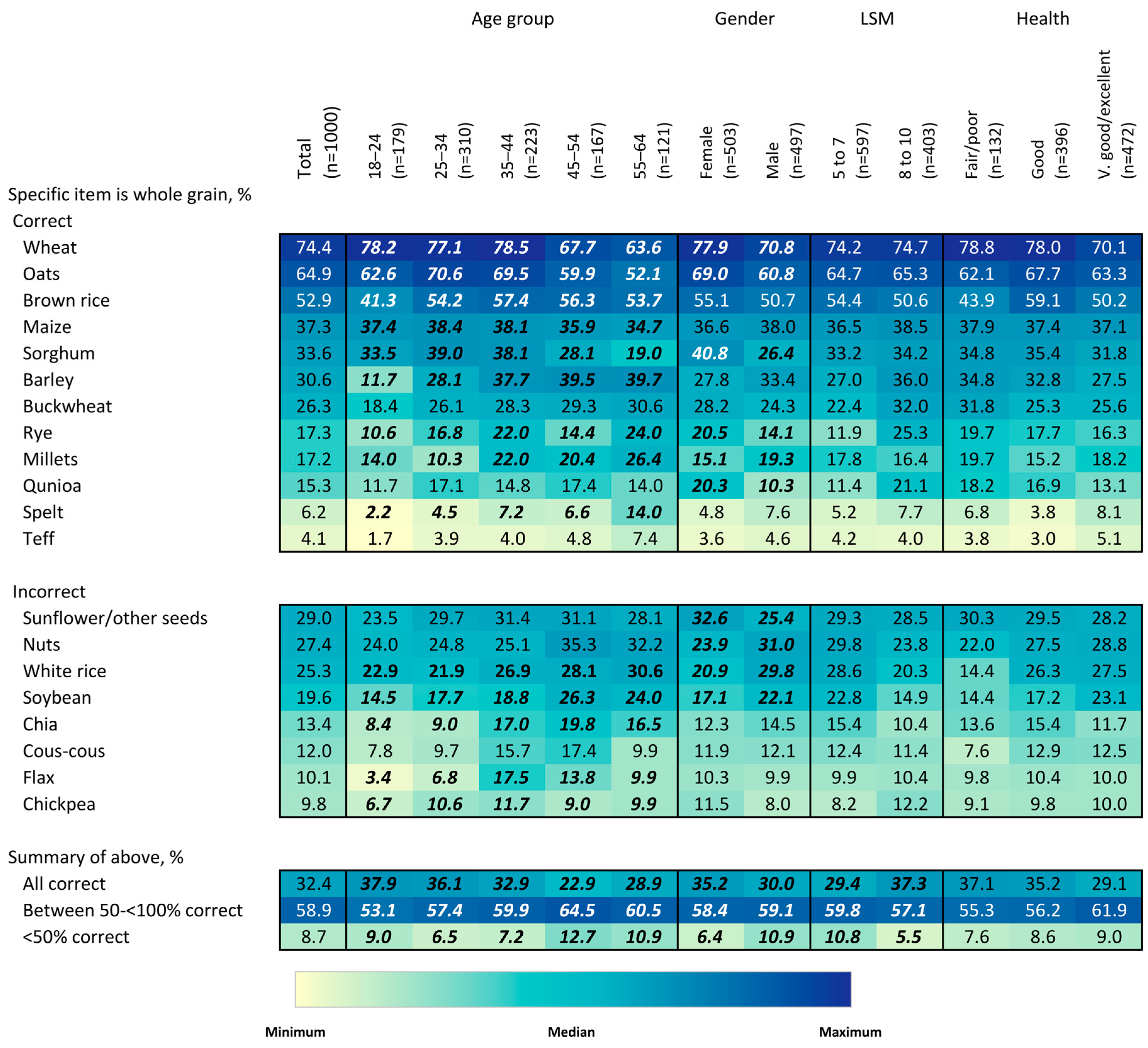
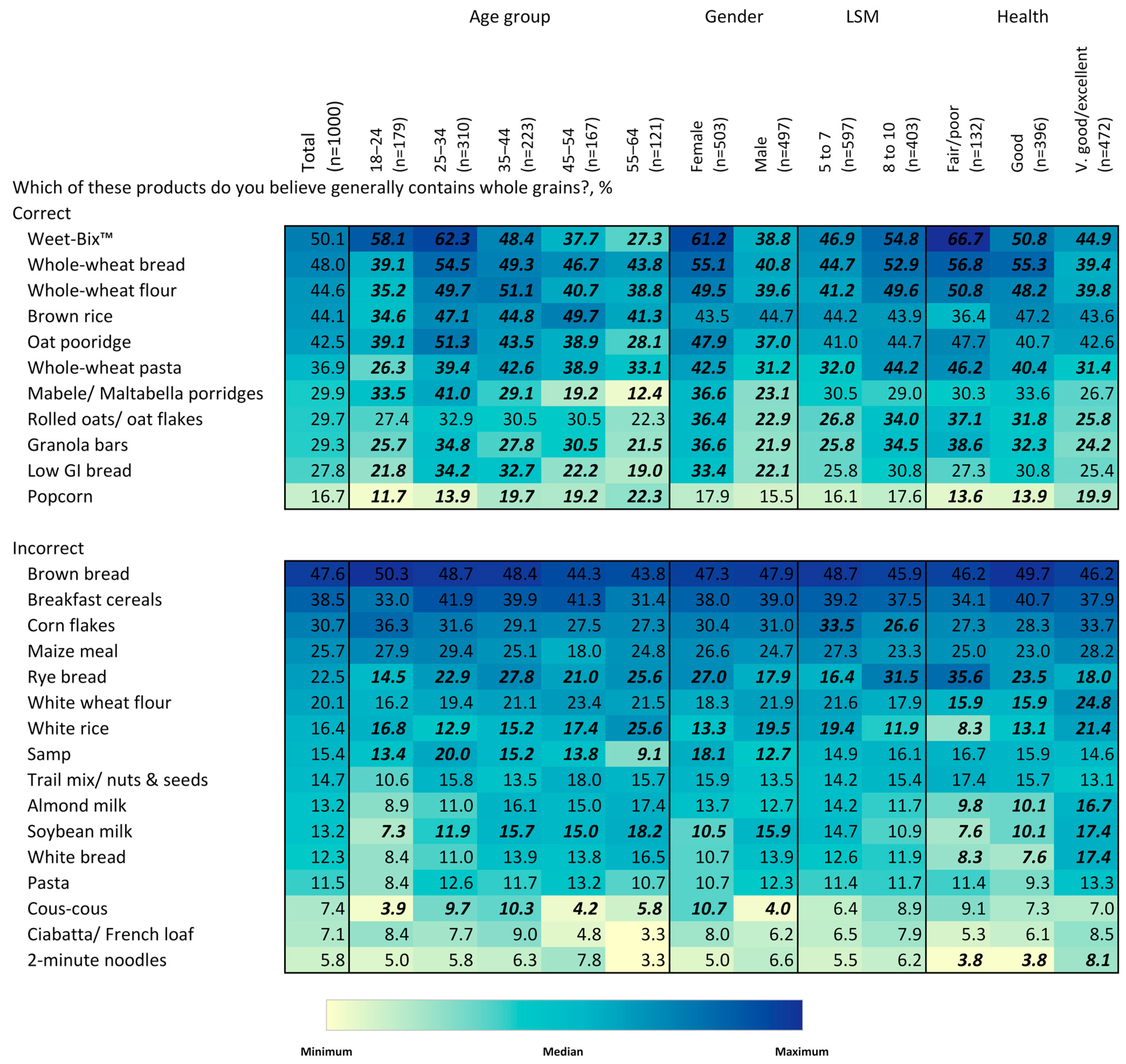
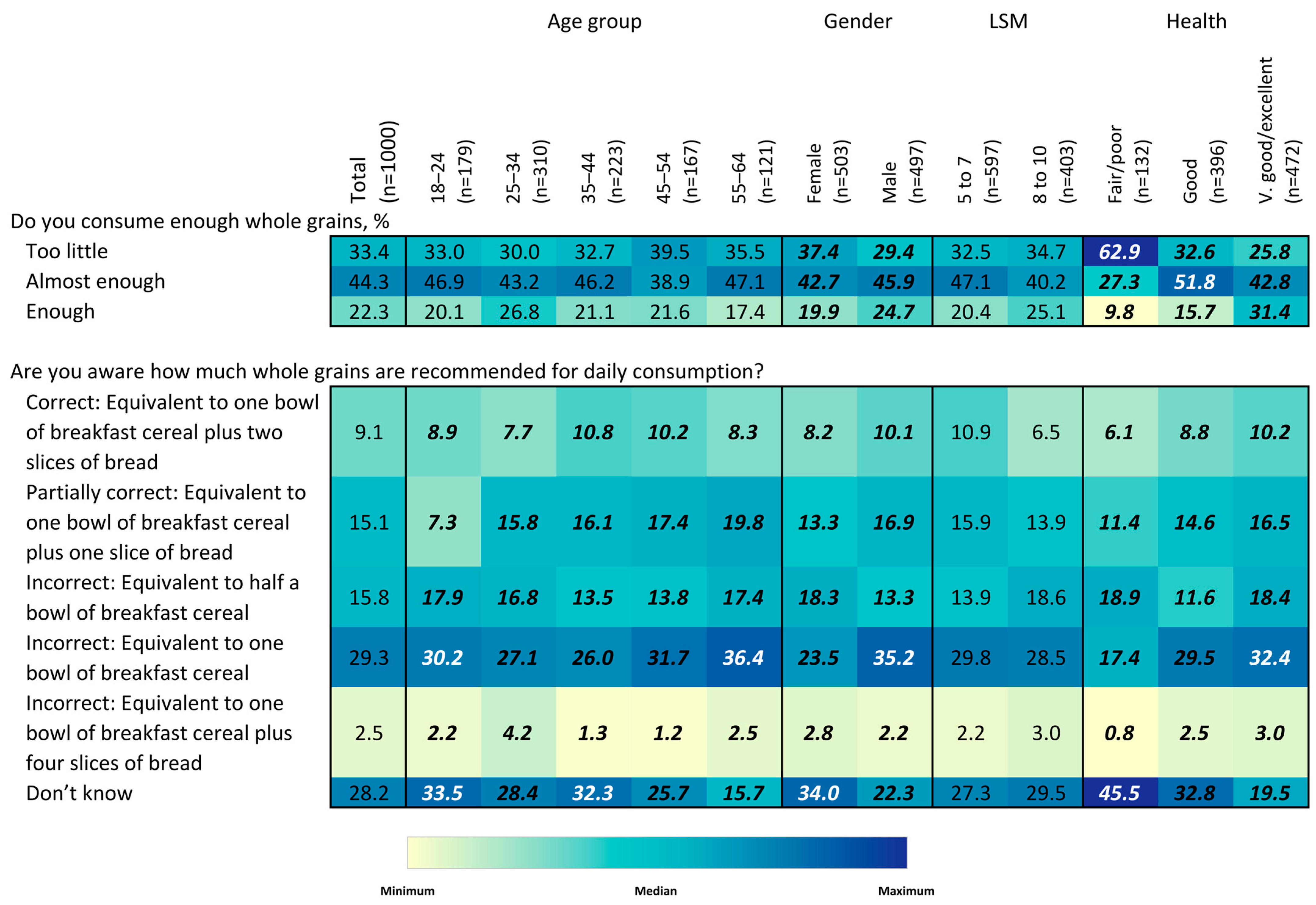
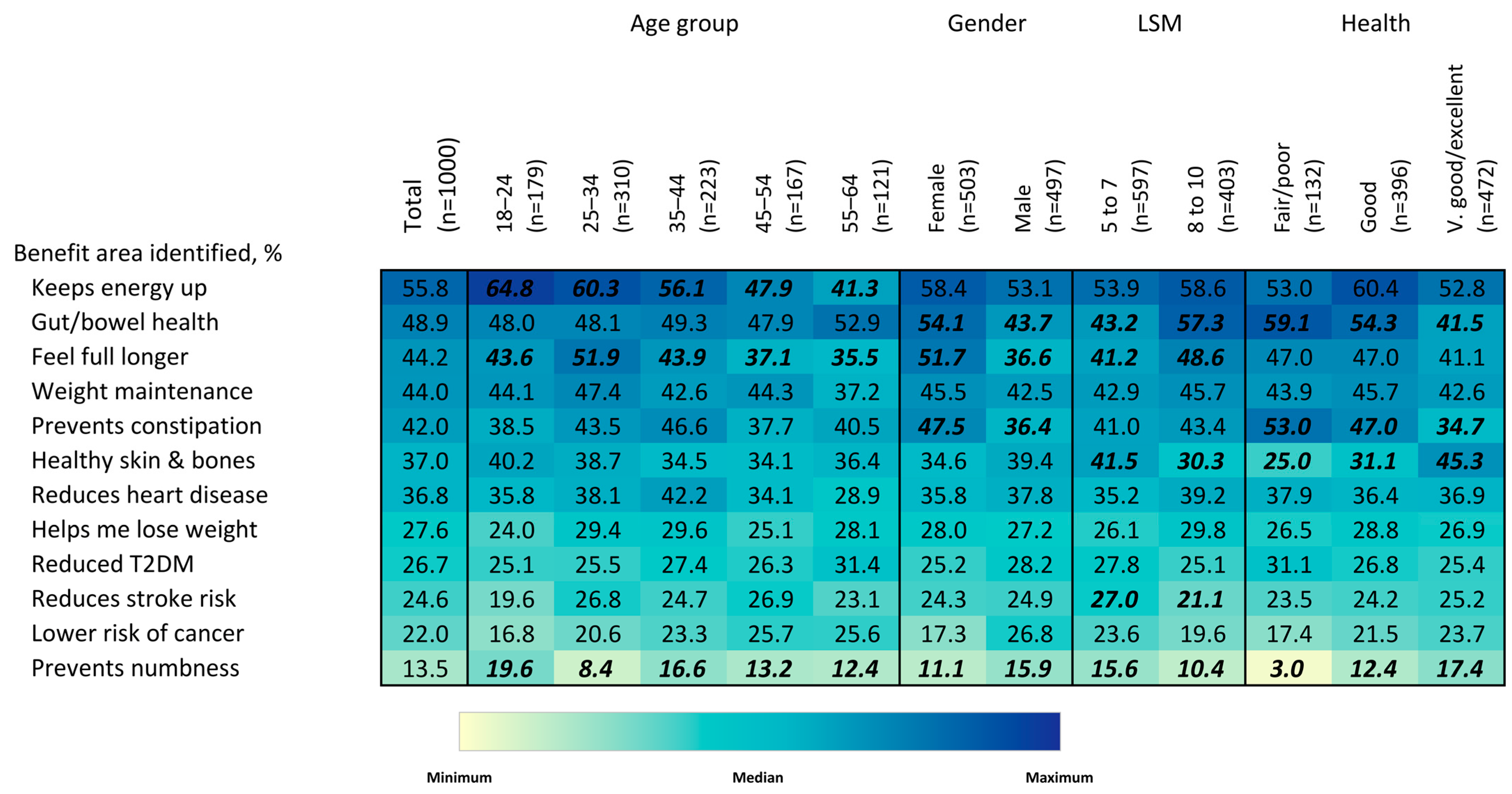
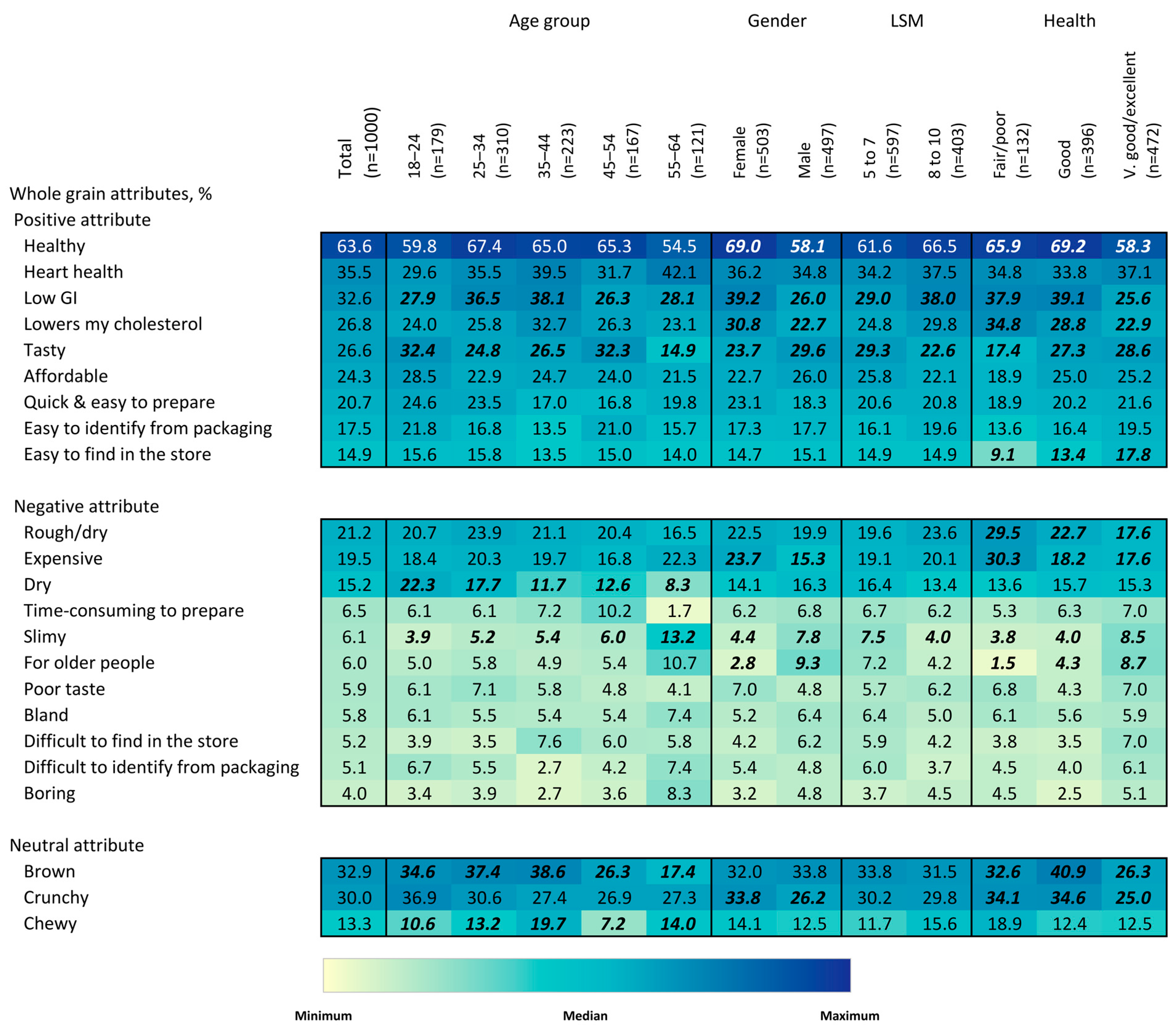
| N | % | |
|---|---|---|
| Total | 1000 | - |
| Age group (y) | ||
| 18–24 | 179 | 17.9 |
| 25–34 | 310 | 31.0 |
| 35–44 | 223 | 22.3 |
| 45–54 | 167 | 16.7 |
| 55–64 | 121 | 12.1 |
| Gender | ||
| Female | 503 | 50.3 |
| Male | 497 | 49.7 |
| Population group | ||
| Black | 764 | 76.4 |
| Coloured/Indian | 130 | 13.0 |
| White | 106 | 10.6 |
| Living Standards Measure (LSM) 1 | ||
| 5–7 | 597 | 59.7 |
| 8–10 | 403 | 40.3 |
| Region (Province) | ||
| Gauteng | 383 | 38.3 |
| KwaZulu-Natal | 153 | 15.3 |
| Western Cape | 127 | 12.7 |
| Other Regions | 337 | 33.7 |
| Self-reported health | ||
| Excellent | 185 | 18.5 |
| Very good | 287 | 28.7 |
| Good | 396 | 39.6 |
| Fair/poor | 132 | 13.2 |
| Characteristics | n (% of Total) | % Respondents with Low or High Subjective Knowledge 1 of Whole Grains | Mean (±Standard Deviation [SD]) 2 | ||||
|---|---|---|---|---|---|---|---|
| Objective Knowledge about Items That Are Whole Grains? | Objective Knowledge about Products Containing Whole Grains? | Total Objective Knowledge Score 3 | |||||
| Low | High | Max = 20 | Max = 26 | Max = 47 | |||
| Subjective Knowledge 1 | High | 640 (64%) | - | - | 10.5 (±2.1) | 17.6 (±2.7) | 28.5 (±4.0) |
| Low | 360 (36%) | - | - | 10.1 (±2.0) | 17.4 (±2.4) | 27.8 (±3.6) | |
| p-value | - | - | 0.001 | 0.22 | 0.005 | ||
| Gender | Female | 503 (50.3%) | 34.5 | 65.4 | 10.6 (±2.0) | 18.1 (±2.6) | 29.1 (±3.7) |
| Male | 497 (49.7%) | 37.4 | 62.6 | 10.1 (±2.1) | 16.9 (±2.5) | 27.4 (±3.8) | |
| p-value | 0.351 | <0.0001 | <0.0001 | <0.0001 | |||
| Age | 18–24 years | 179 (17.9%) | 30 | 70 | 10.1 (±1.8) a,b | 17.5 (±2.2) a,b,c | 28.0 (±3.1) a,b,c |
| 25–34 years | 310 (31.0%) | 37.1 | 62.8 | 10.6 (±2.1) b | 18.0 (±2.5) c | 29.0 (±3.6) c | |
| 35–44 years | 223 (22.3%) | 32.7 | 67.3 | 10.5 (±2.0) b | 17.6 (±2.9) b,c | 28.5 (±4.0) b,c | |
| 45–54 years | 167 (16.7%) | 43 | 57 | 10.0 (±2.2) a | 17.3 (±2.6) a,b | 27.7 (±4.1) a,b | |
| 55–64 years | 121 (12.1%) | 43.1 | 56.9 | 10.2 (±2.4) a,b | 16.7 (±2.7) a | 27.2 (±4.6) a | |
| p-value | 0.009 | 0.021 | <0.0001 | <0.0001 | |||
| LSM | LSM 5–7 | 403 (40.3%) | 40.5 | 59.5 | 10.1 (±2.0) | 17.2 (±2.6) | 27.7 (±3.8) |
| LSM 8–10 | 597 (59.7%) | 29.3 | 70.7 | 10.7 (±2.1) | 18.0 (±2.5) | 29.2 (±3.7) | |
| p-value | <0.001 | <0.0001 | <0.0001 | <0.0001 | |||
| All respondents | 1000 | 10.3 (±2.1) | 17.5 (±2.6) | 28.3 (±3.8) | |||
Disclaimer/Publisher’s Note: The statements, opinions and data contained in all publications are solely those of the individual author(s) and contributor(s) and not of MDPI and/or the editor(s). MDPI and/or the editor(s) disclaim responsibility for any injury to people or property resulting from any ideas, methods, instructions or products referred to in the content. |
© 2023 by the authors. Licensee MDPI, Basel, Switzerland. This article is an open access article distributed under the terms and conditions of the Creative Commons Attribution (CC BY) license (https://creativecommons.org/licenses/by/4.0/).
Share and Cite
Taylor, J.R.N.; Rehm, C.D.; de Kock, H.L.; Donoghue, S.; Johnson, A.; Thompson, C.; Berezhnaya, Y. South African Consumers’ Knowledge, Opinions and Awareness of Whole Grains and Their Health Benefits: A Cross-Sectional Online Survey. Nutrients 2023, 15, 3522. https://doi.org/10.3390/nu15163522
Taylor JRN, Rehm CD, de Kock HL, Donoghue S, Johnson A, Thompson C, Berezhnaya Y. South African Consumers’ Knowledge, Opinions and Awareness of Whole Grains and Their Health Benefits: A Cross-Sectional Online Survey. Nutrients. 2023; 15(16):3522. https://doi.org/10.3390/nu15163522
Chicago/Turabian StyleTaylor, John R. N., Colin D. Rehm, Henriëtte L. de Kock, Suné Donoghue, Andrew Johnson, Chanelle Thompson, and Yulia Berezhnaya. 2023. "South African Consumers’ Knowledge, Opinions and Awareness of Whole Grains and Their Health Benefits: A Cross-Sectional Online Survey" Nutrients 15, no. 16: 3522. https://doi.org/10.3390/nu15163522
APA StyleTaylor, J. R. N., Rehm, C. D., de Kock, H. L., Donoghue, S., Johnson, A., Thompson, C., & Berezhnaya, Y. (2023). South African Consumers’ Knowledge, Opinions and Awareness of Whole Grains and Their Health Benefits: A Cross-Sectional Online Survey. Nutrients, 15(16), 3522. https://doi.org/10.3390/nu15163522







